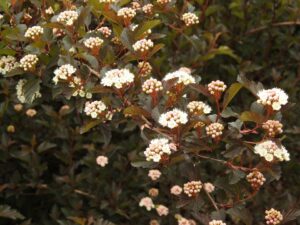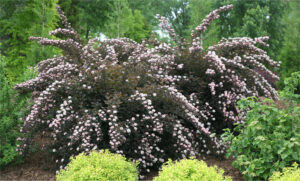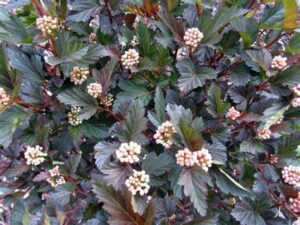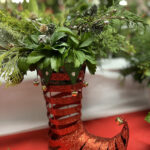Native to eastern North America, Physocarpus opulifolius (Common Ninebark) or one of its many cultivars is a beautiful, easy way to incorporate native shrubs into your landscaping. A versatile, deciduous flowering shrub, Ninebark is named for its exfoliating bark, which peels in strips to reveal several layers of reddish to light brown inner bark.
deciduous flowering shrub, Ninebark is named for its exfoliating bark, which peels in strips to reveal several layers of reddish to light brown inner bark.
There are 8 species of ninebark and numerous cultivars. All feature arching branches and range in size from 3 to 8 feet tall and wide, depending on type. Physocarpus of any variety makes an excellent hedge plant and provides good erosion control.
Its leaves are of many different colors, commonly purple/burgundy and yellow, fit for every color scheme.
Ninebark bears bountiful clusters of white to pinkish flowers resembling spirea between May and June. Its flowers are excellent for pollinators, as both short and long-tongued bees can access the flower nectar. Flowers give way to drooping clusters of reddish fruit (inflated seed capsules) for birds in the fall.
A ninebar k shrub should be given enough space, as well as regular pruning, so its arching branches can be fully appreciated. When used in a mixed shrub border, it works well with lilac and spirea. It will grow in partial shade, but will perform best in full sun. Ninebark will grow in both dry and wet locations. Its water requirements are generally low.
k shrub should be given enough space, as well as regular pruning, so its arching branches can be fully appreciated. When used in a mixed shrub border, it works well with lilac and spirea. It will grow in partial shade, but will perform best in full sun. Ninebark will grow in both dry and wet locations. Its water requirements are generally low.
This is an easy-care shrub with minimal pruning and feeding needs. It is remarkably tolerant of many growing conditions, including drought, and it is generally free of pest problems and diseases.
When necessary, prune ninebark after it flowers or no later than mid-August to maintain its shape and thin out branches. Older shrubs can be pruned close to the ground for winter to renew the plant and encourage better leaf and flower growth. Plants can be divided in the early spring, with a sharp spade, chopping right through the middle. Softwood and hardwood cuttings are easy to root.







